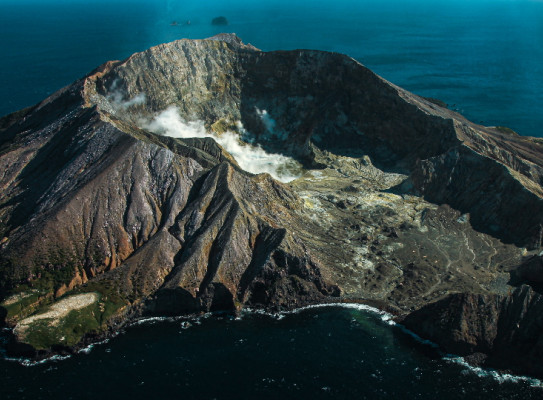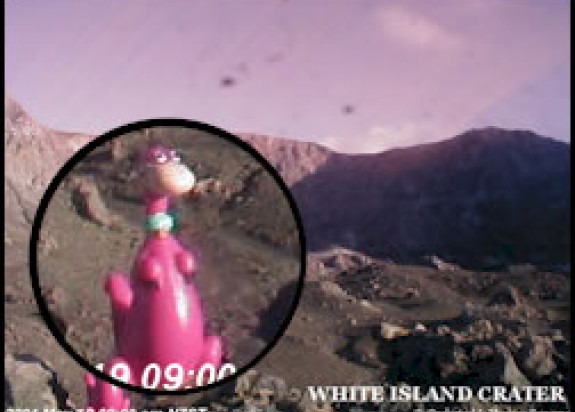Pink dinosaur becomes global celebrity

The little pink mascot that suddenly appeared on the Whakaari volcano-cam this month has turned into a global phenomenon.
Dino, the diminutive dinosaur that has been a constant companion for the solar-powered digital camera on Whakaari in recent weeks, has popped up on websites all over the world.
Traffic on the GeoNet website has averaged 600 hits a minute since the story broke a week ago. Most visitors are from outside New Zealand.
The volume has forced GNS to reduce the size of the volcano-cam images on the website. Strangely, interest in the images has remained just as strong.
"No-one could have predicted that the appearance of a tiny toy on a remote New Zealand island would have made such a splash internationally," GNS spokesman John Callan said.

No-one could have predicted that the appearance of a tiny toy on a remote New Zealand island would have made such a splash internationally
GNS has received emails from all over the world, some from people who had not heard of New Zealand before. CNN and The New York Times are among a long list of media to have probed Dino's popularity.
Owners of the volcano-cam, Geological and Nuclear Sciences (GNS), have no plans to separate Dino from his rock. GNS staff have grown attached to Dino and are surprised by his popularity.
"Eventually the acidic environment on the island will probably bring about his demise. This could take many months, but we're not making any firm predictions.
"In terms of outreach, Dino has been brilliant. He has a real flair for promoting earth sciences and New Zealand."
For those who slept through their geography classes, Whakaari is an active volcano 50km offshore from the Bay of Plenty. The uninhabited, privately-owned island continuously steams, and erupts every few years.
The GeoNet Group of GNS monitors volcanic activity on all of New Zealand's active and recently active volcanoes. As well as helping scientists understand how volcanoes work, there's a public safety angle too. Tourism operators take clients to Whakaari almost every day.
Solar-powered volcano-cams have been a fantastic development. From the mainland, GNS scientists now have an hour-by-hour visual check on what their seismic instruments on Whakaari are telling them.
The camera is housed in a strongly-built box that is bolted to the remains of an old sulphur factory on the island. Sulphur was mined on Whakaari from the 1880s to the 1930s. The mine was abandoned in the 1930s when world prices took a tumble and it became uneconomic to ship sulphur from the island.
The factory building is crumbling away in the acidic environment. Exploring the remains of the building is part of the visitor experience. The GNS volcano-cam and its solar panel are fairly obvious to those who explore the abandoned factory.
"In the past, we've seen faces, hands, and other body parts in front of our volcano-cam. Unlike Dino, they have been fleeting images."
The camera is elevated and about 700m from the most active part of the crater. It gives the viewer a good perspective while keeping a respectable distance from the steam, ash, and ballistic missiles that the crater sometimes produces.
At its angriest, Whakaari crater has hurled orange-sized rocks into the sea - a distance of 1km.
Other GNS volcano-cams - at Ruapehu, Ngauruhoe and Taranaki-Egmont - have not been affected by toy mascots.